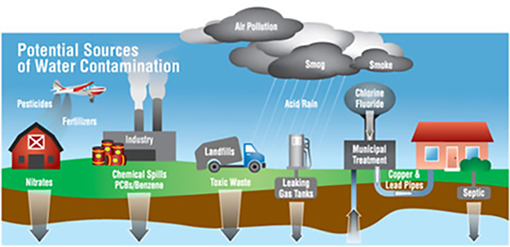2.4 Surface and groundwater
Pollutants from liquid waste can seep into groundwater or flow into rivers or lakes. Where wells and boreholes are used to access groundwater for drinking and domestic purposes, or surface water from rivers is used for such purposes, this can introduce a high level of risk. The major danger in urban Ethiopia is contamination from faeces, although pesticides and industrial waste may also cause contamination of water. Figure 2.7 summarises potential sources of water contamination.

List two major environmental contaminants in the liquid waste category and explain why they pose a health risk.
You may have thought of:
- human excreta from pit latrines and septic tanks, which may contain dangerous pathogens
- liquid medical wastes from health centres, which may also contain pathogens
- industrial wastewater, which may contain toxic chemicals.
2.3 Liquid waste
